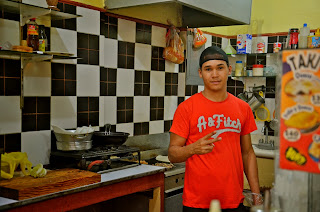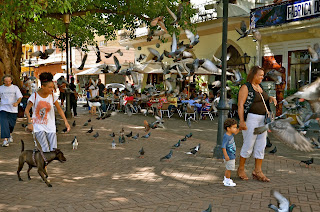The Dominican Republic has become the ultimate paradise for cigar lovers. Since the the Spanish arrived in 1492, tobacco has been a driving part of both the island's history and culture. The Taino, the first inhabitants of the island, were using tobacco on the island in their social, religious and ceremonial activities centuries before the Europeans arrived.
Today, Dominican cigars are exported to the United States and compete on the same level as Cuban cigars in the European market. The La Boutique Del Fumador specializes in CaOba handrolled cigars. Founded by Julio Perez Gonzalez, an immigrant from Coruna, Spain, opened in 1992, at the conde Street, on the Colon Park, in Santo Domingo's colonial zone where we stayed.
Handmade cigars are usually more expensive. They are often classified as premium or super premium cigars. The most coveted handmade cigars in the world cost upwards of twenty dollars. A few cost over a hundred. The cigar brands manufacturered by CaOba are Taino, Tamy, and CaOba. About 2 millions cigars are produced yearly... all handrolled. Caoba states that their cigars are not an expense, but are an investment in pleasure.
LA and the cigar salesman discuss the many types of cigars available for sale. LA

LA chose the CaOba Gold cigar. It is a medium-flavored cigar built from Dominican fillers and binders. The binders have been vaporized with premium Dominican rum. They are aged a minimum of two years in CaOba's cedar vaults.
Cigars were handrolled in the shop. It was interesting to watch as the cigar maker deftly rolled the cigars.
A handmade cigar is made up of three parts—the filler, the binder, and the wrapper. Each of these parts serves a specific purpose.
 |
| Note the cutting board.. it is a cross section from a tree trunk. |

The binder goes around the filler to contain it. It is tobacco leaf and is pliable and silky, and it is actually rougher than the wrapper. It has no flavor, but it is essential because it helps give the cigar its shape and holding by the filler at just the right density.
 |
| The metal disc on the cutting board is a chaveta. |
After a close inspection of the leaf, the best part is picked and carefully cut into the optimum shape for wrapping the cigar. Surprisingly, as much as 75 percent of the cigar's flavor and aroma comes from the wrapper. The finest wrappers are grown in Connecticut, Cameroon, Cuba, and the Dominican Republic. A good wrapper has a slightly oily texture and lustrous sheen that feels firm when held between the fingers.The wrapper on a handmade cigar is made from extremely high quality tobacco. It has a smooth texture and feels oily to the touch. It must burn steadily and contribute to taste.
 |
| The finished product! |
Finally, using a little more vegetable glue, the cigar band is added to complete the hand made cigar. The only non-tobacco portion of a cigar is the very small amount of vegetable glue that holds the cigar together. A metal cutter, shown in the photo above, is used to cut off the end of the cigar.
Click on the 60 sec video below to watch a Dominican worker creating a Dominican cigar. Don't be fooled by how quickly he works… he is very skilled at what he does and is creating a work of art with techniques handed down from generation to generation.
























































